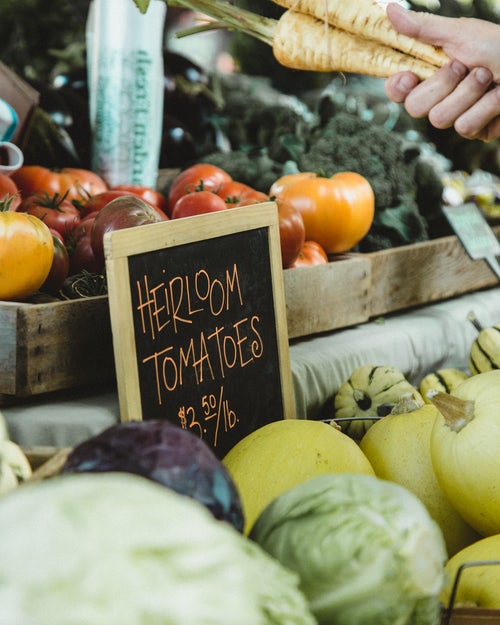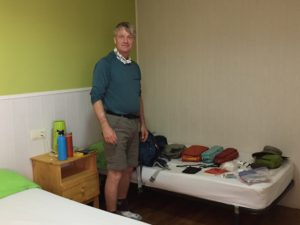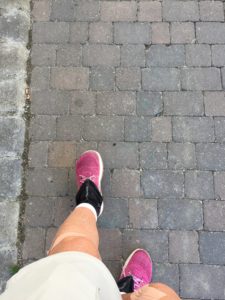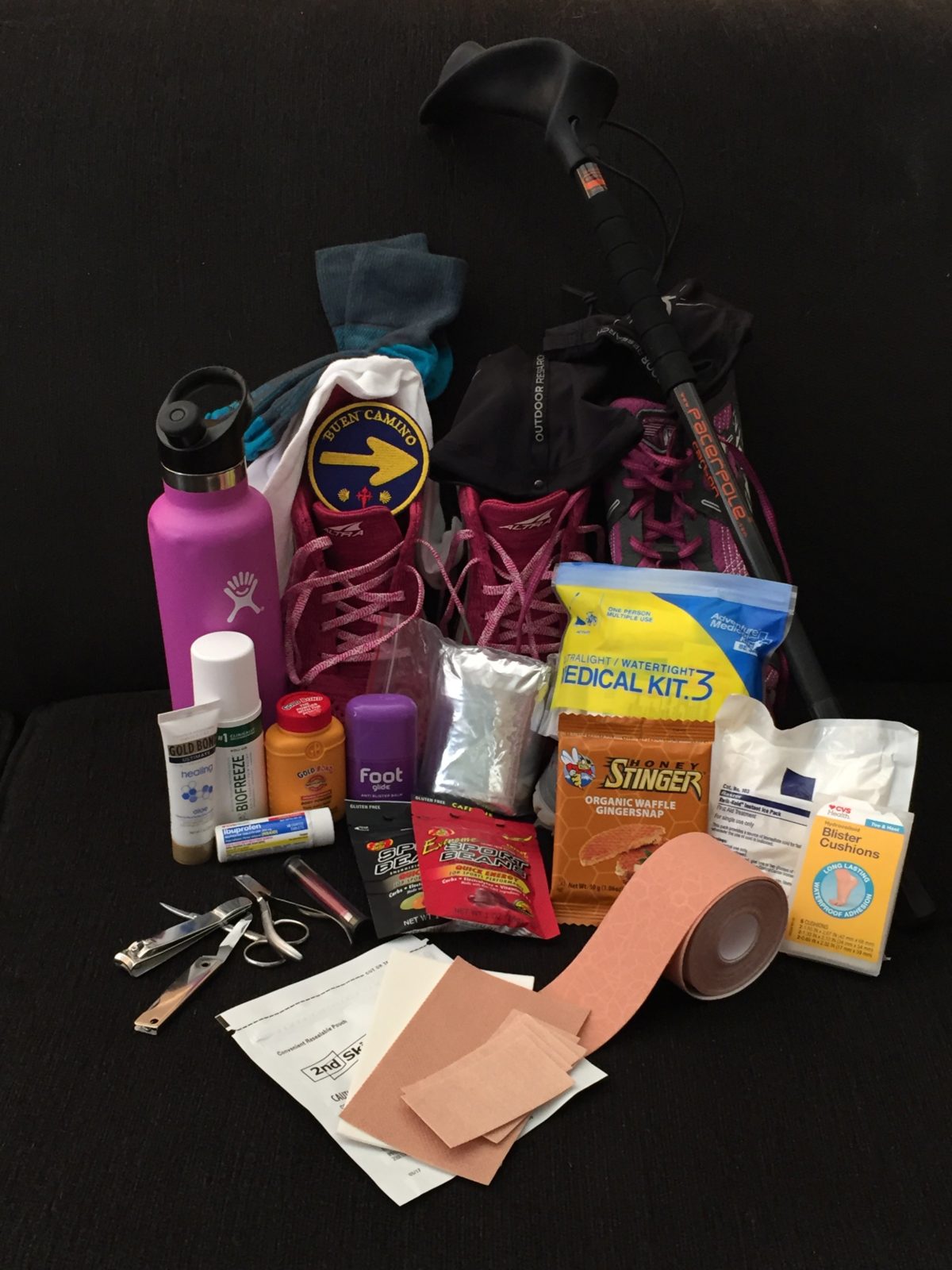I thought we were going to have to eat it for every meal while walking the Camino. All the books said we’d have to, that the Spaniards consume it for lunch and dinner, and that breakfast would only be a hard (read: stale) piece of bread for breakfast. Maybe you’d get lucky and find a place open early enough for a café con leche.
WELLLLL, it could be that we hit the jackpot, all of the Camino books I read were old and wrong, or the establishments are trying to meet the demands of more discriminating (and maybe demanding?) pilgrims.
Whatever it is, we didn’t have to eat the ubiquitous ham sandwich or pork dinner if we didn’t want to.
We weren’t stuck with ham and a sliver-of-cheese sandwich. We didn’t have only pork tenderloin for dinner.
Instead, we were treated to exquisitely fresh and varied meals for nearly every day of our journey.
A lot of it!
Fresh bananas, oranges and apples were prevalent. We often packed those along for a mid-morning snack with a hunk of delicious Basque cheese, since we elected not to get bogged down physically by a big breakfast.
Sometimes we’d treat ourselves to a HUGE flaky, buttery croissant, or one stuffed with dark chocolate (Chris’s personal fave) and cup of café con leche, but most of the time we waited until mid-morning to stop for a short break and nibble.
Then we’d usually walk through lunch and have a sandwich or more substantial snack after we stopped walking, around 2:00 – 3:00 in the afternoon. Sometimes the sandwich would be one we’d purchased that morning and saved, or was a fresh one we found at an open store. (When we arrived in a new city nearly all of the places were closed for siesta, so we had to wait until they re-opened. In some towns that was five-ish; in other places it was 6:00 or 7:00. You never could be too sure about what you’d encounter, so you learned to be prepared in the meal or snack-to-tide-you-over department.
And many of the towns had markets open early enough to enjoy a cafe con leche before heading out. One wonderful and noteworthy Lorca albergue we stayed in offered a nice breakfast selection.
3-Course Meals—
But nearly every dinner we enjoyed was a three-course meal affair, with several selections for each course.
The “Salad Mixta” was usually a large plate of greens, a sliced hard-boiled egg, tuna fish, fresh tomatoes, white asparagus and tomatoes (and sometimes roasted red pepper strips), maybe a sprinkling of cheese or corn kernels. A light coating of olive oil and a sprinkle of salt served as the dressing. I was usually full and adequately satisfied after the salad, which I always ordered.
Then the second course was an equally humongous plate of pork tenderloin, albondigas (meat and pork meatballs) in a delicious, mildly sweet roasted red pepper sauce, a pasta dish or a fresh fish dish. I lost count of how many plates of northern Spain sea bass tenderloin or bacalao (cod) with a pepper sauce coating I consumed. And I didn’t tire of it.
Dessert might have been flan (always offered), ice cream, cheesecake, tiramisu, or a choice of whole fruit. Occasionally a monstrous slab of chocolate fudge cake with mounds of whipped cream was a selection.
And the dessert (unless it was a ubiquitous Nestle concoction), didn’t taste as though it contained nearly as much sugar as our American varieties. So the ingredient flavors were not overpowered by the super sweet sugar.
Oh, and every dinner came with a full bottle of red wine. (The daily imbibing on the cheap motivates a lot of people to walk the Camino).
I can count on three fingers how many times I had wine, which includes a glass of rose in France, a sip of red somewhere in Spain, and enough to dampen end of my tongue at the famous Fuente del Vino (Fountain of Wine) at Bodegas Irache.
No way was I going to walk the Camino on a glass of wine, as some unfortunate pilgrims tried (and failed) to do successfully.
Energy to spare on reduced rations and exercise—
What we noticed was how physically and emotionally satisfied we felt with the meal strategy.
Although we consumed a lot of calories for dinner, walking five to six hours a day quickly burned that off.
But exercising on a primarily empty or lightly filled stomach allowed our bodies to more efficiently burn fuel without us feeling sluggish or uncomfortably stuffed.
It was something I used to practice religiously—not eating before exercising—but had abdicated, primarily in favor of convenience or meeting others’ schedules.
But now we’re back to it. And we feel SO much better! And physically lighter. Keeps the brain sharper too. That practice also fits into the popular Keto diet, where you’re running in caloric deficit and burning ketones.
Opting for fresh food—
Another thing we noticed was just how much more we enjoyed REALLY fresh (like right off the adjacent farm) food.
Anyone who had the joy of biting into a beefsteak tomato thirty years ago knows how disappointing our current overgrown, overproduced, GMO’d tomatoes we get today are.
In France and Spain, we once again enjoyed the real deal—plump, fresh, juicy, right-off-the-vine, organic tomatoes. Many tasted like heirloom varieties.
And we’re not going back to the tasteless type.
Shopping and cooking fresh—
Now I’m taking the time to shop frequently—about every other day—for fresh (and organic) everything:
- Fresh fish
- Fresh veggies
- Fresh fruit
- Fresh meat (which we rarely consume now)
- Fresh milk
- Fresh cheese
- Fresh bread
- You name it. It gets purchased fresh and consumed. Not much frozen anymore, except maybe berries.
Hello, farmers markets!
Chris and I are becoming weekend regulars at the local farmers market, returning to our favorite handpicked produce sellers, the adorable bread baker who kneads and molds her artisan bread with her gnarled rheumatoid arthritic hands. The former Wall Street worker who sold it all and moved to a Sonoita ranch (on the Arizona-Mexico border) to raise grass-fed cattle gets attention for her delicious ground meat and sausage (and hydrating purified rain water blended with rose water and 6 vital essential oils).
And I’m really enjoying the art of preparing and cooking, making a game out of seeing what I can combine for flavors. You’d be surprised what tastes good together!
I’ve even cracked open the Great Courses DVD and book The Everyday Gourmet: Rediscovering the Lost Art of Cooking compiled by The Culinary Institute of America. I started it a couple of years ago and am excited to re-start and finish it, improve my skills and cooking joy!
Cooking can be fun and relaxing. Something you can take pride in doing. Something that joggles the imagination and adds variety to life. It can also be a very social event, as when you and your hubby are chatting and chopping and stirring and laughing.
Makes me wonder when they’re going to get wise and re-introduce home economics back into the schools—for girls AND boys!
And all of that is reaping side benefits:
- Enjoying my market and food shopping time—browsing the produce to see what’s available, planning my meals based on the available (and in-season) ingredients.
- Getting exercise by moving around the kitchen more when I’m cooking, and more often in general, since I’m spending more time in food preparation.
- Slowing down and enjoying the slower pace of life.
- Getting outside in the fresh air to stroll through a farmers market and enjoy friendly conversation with vendors.
- Enjoying meals more.
- Spending less money on food because more gets eaten and less gets wasted!
- Did I say saving money?
- Except for dinner, which we’re trying to eat by 6:00 PM, we’re no longer married to specific times for breakfast and lunch. Sometimes we eat a late breakfast, skip lunch and then enjoy an early late lunch/early dinner. It certainly helps with the sleep!
NEXT WEEK I’ll add something to this topic that will help you emotionally, physically and spiritually. (Especially through the holidays!)
Until then, happy farmers market browsing!
Blessings,
Andrea
May you prosper in all things and be in health, just as your soul prospers (3 John 2).
Photo by Dane Deaner on unsplash




 When you’re preparing to leave one place you know you won’t be returning to and walking 5 – 15 miles to another location, you plan carefully. You spend some time thinking about what you’re going to wear, how you’re going to pack, in case the weather changes and you need to shed a jacket or get to your rain gear and poncho in a hurry. If you happen to leave something back at the place you slept, you think long and hard about whether you really need it. About whether or not you can buy a replacement in the next tiny village you sleep in.
When you’re preparing to leave one place you know you won’t be returning to and walking 5 – 15 miles to another location, you plan carefully. You spend some time thinking about what you’re going to wear, how you’re going to pack, in case the weather changes and you need to shed a jacket or get to your rain gear and poncho in a hurry. If you happen to leave something back at the place you slept, you think long and hard about whether you really need it. About whether or not you can buy a replacement in the next tiny village you sleep in.
